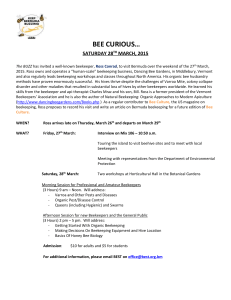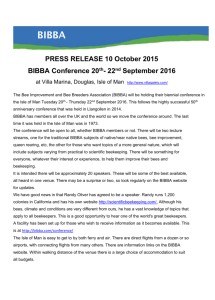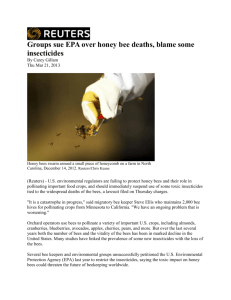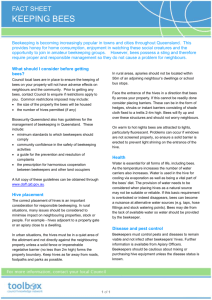Bee Line April 2012 Final.pub - Sacramento Area Beekeepers
advertisement
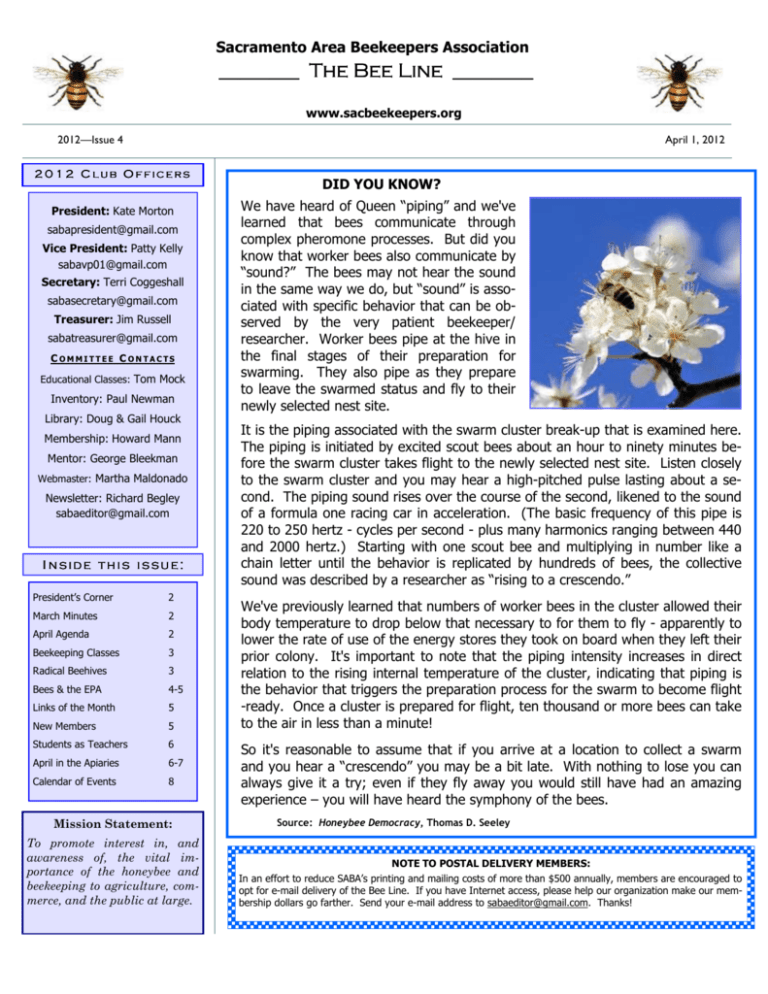
Sacramento Area Beekeepers Association ________ The Bee Line ________ www.sacbeekeepers.org 2012—Issue 4 April 1, 2012 2 0 12 C LUB OFFICERS President: Kate Morton sabapresident@gmail.com Vice President: Patty Kelly sabavp01@gmail.com Secretary: Terri Coggeshall sabasecretary@gmail.com Treasurer: Jim Russell sabatreasurer@gmail.com C OMMITTEE C ONTACTS Educational Classes: Tom Mock Inventory: Paul Newman Library: Doug & Gail Houck Membership: Howard Mann Mentor: George Bleekman Webmaster: Martha Maldonado Newsletter: Richard Begley sabaeditor@gmail.com INSIDE THIS ISSUE: President’s Corner 2 March Minutes 2 April Agenda 2 Beekeeping Classes 3 Radical Beehives 3 Bees & the EPA 4-5 Links of the Month 5 New Members 5 Students as Teachers 6 April in the Apiaries 6-7 Calendar of Events 8 Mission Statement: To promote interest in, and awareness of, the vital importance of the honeybee and beekeeping to agriculture, commerce, and the public at large. DID YOU KNOW? We have heard of Queen “piping” and we've learned that bees communicate through complex pheromone processes. But did you know that worker bees also communicate by “sound?” The bees may not hear the sound in the same way we do, but “sound” is associated with specific behavior that can be observed by the very patient beekeeper/ researcher. Worker bees pipe at the hive in the final stages of their preparation for swarming. They also pipe as they prepare to leave the swarmed status and fly to their newly selected nest site. It is the piping associated with the swarm cluster break-up that is examined here. The piping is initiated by excited scout bees about an hour to ninety minutes before the swarm cluster takes flight to the newly selected nest site. Listen closely to the swarm cluster and you may hear a high-pitched pulse lasting about a second. The piping sound rises over the course of the second, likened to the sound of a formula one racing car in acceleration. (The basic frequency of this pipe is 220 to 250 hertz - cycles per second - plus many harmonics ranging between 440 and 2000 hertz.) Starting with one scout bee and multiplying in number like a chain letter until the behavior is replicated by hundreds of bees, the collective sound was described by a researcher as “rising to a crescendo.” We've previously learned that numbers of worker bees in the cluster allowed their body temperature to drop below that necessary to for them to fly - apparently to lower the rate of use of the energy stores they took on board when they left their prior colony. It's important to note that the piping intensity increases in direct relation to the rising internal temperature of the cluster, indicating that piping is the behavior that triggers the preparation process for the swarm to become flight -ready. Once a cluster is prepared for flight, ten thousand or more bees can take to the air in less than a minute! So it's reasonable to assume that if you arrive at a location to collect a swarm and you hear a “crescendo” you may be a bit late. With nothing to lose you can always give it a try; even if they fly away you would still have had an amazing experience – you will have heard the symphony of the bees. Source: Honeybee Democracy, Thomas D. Seeley NOTE TO POSTAL DELIVERY MEMBERS: In an effort to reduce SABA’s printing and mailing costs of more than $500 annually, members are encouraged to opt for e-mail delivery of the Bee Line. If you have Internet access, please help our organization make our membership dollars go farther. Send your e-mail address to sabaeditor@gmail.com. Thanks! Page 2 ———- THE BEE LINE ——— April 2012 President’s Corner Thanks to Ernie Buda for last month’s presentation on swarm capture – his handout is certainly wonderful to use for reference; though each swarm is unique, the many aspects he covered help make this particular bee experience easier. This iffy weather lately has made it difficult to plan for splits of our own overcrowded hives and Jim and I have had more than our share of swarms in the past weeks. Luckily, we have had members offer boxes to fill with swarms and help to fetch away a few, but splits are foremost in future plans for my days off next week. Letting the bees make a supercedure queen cell in the splits I managed to get in between the rain storms works, but does take some time to complete the natural cycle. Learning queen propagation when I attend Serge Labesque’s class in May will give me more education – and hopefully save money when planning re-queening throughout the years. We will have an interesting presentation for next meeting – a setup and demonstration of our SABA event materials with several experienced members highlighting the honeybee info they like to impart when speaking to the public. Nicki Larson will also give a talk on the South African beekeeper trip she organizes with fascinating pictures of the locals, locales and much enthusiasm. Kate Morton Minutes of Monthly Business Meeting - March 20, 2012 Meeting called to Order (7:12pm) New Member Introductions; Quorum Confirmation: 63 members Present (quorum reached). Approval of February 2012 Minutes: Ernie Buda made the motion for approval and Larry Hutteball seconded it – motion was passed by vote of the membership Treasurer Report (Jim Russell): $5,095.57 Savings; $9,291.86 Checking; 25 new members from February. Committee Reports Classes: Tom Mock not present; Queen Propagation Classes (Ernie Buda) – 20 signed up, 17 paid. Flyers available, encouraged mentors to attend at no cost; Serge Labesque will teach new, easier method. Events: Patti Kelly--Ag Day at the Capitol March 21. Kaiser Earth Day April 19; volunteers wanted; Sacto County Fair May 24-28; more details to follow. Event Training – Dennis Larson: no new information Unfinished Business Yahoo group discussion (Terri Coggeshall) - Basic discussion of pros of creating a Yahoo group; membership agreed to start one. Postal rates discussion by Richard Begley - Current cost of $79 monthly/$500+ annually for 39 members receiving mailed hard copies; requested additional dues assessment for those members. Membership discussion, but no decision reached. New Business: Scholarships: Kate Morton proposed exploratory committee; class fees should be used for educational materials and/or scholarships. Ernie Buda’s opinion was that organization money should not be given to non-members for scholarships. Nathan Amboy, Mary Ikehara and Lindsey Weaver volunteered to explore scholarship possibilities Request to have a greeter at monthly meetings (Nicki Larson) - Beginning at April meeting Nicki will have sign-up sheet for members who wish to be greeters. Nominating Committee: George Bleekman now the only member; need volunteers to work with George to establish role criteria for Exec. Board officers and appointed positions. The Beekeeper’s Bible ($35) highly recommended by Howard Mann. Adjournment (7:53 p.m.) Ernie Buda moved for adjournment; seconded by Richard Begley; motion passed by vote of membership. Monthly Business Meeting Agenda April 17, 2012 I. Meeting called to Order New Member Introductions II Quorum Confirmation / Approval of March 2012 Minutes III. Treasurer Report IV. Committee Reports a. Classes - Tom Mock & Ernie Buda b. Events – Patty Kelly c. Event Training - Dennis Larson V. Unfinished Business Yahoo group creation Volunteers for Nomination of Officers Committee VI. New Business VII. Meeting Adjournment Page 3 ———- THE BEE LINE ——— April 2012 2012 BEEKEEPING CLASSES DAY / DATE INSTRUCTOR BEGINNING-LEVEL CLASSES Saturday, April 7th Randy Oliver QUEEN PROPAGATION CLASS * Saturday, May 19th Serge Labesque INTERMEDIATE-LEVEL CLASSES Saturday, June 23rd Sunday, July 15th Serge Labesque Randy Oliver ADVANCED-LEVEL CLASS Saturday, July 28th Dr. Eric Mussen All classes will be held at the UCD Extension Center, 4145 Branch Center Road (off Kiefer Road west of Bradshaw Road). Check-in for classes starts at 7:30 a.m.; classes end at 4:00 p.m. (approximately). Class fees: $35 for SABA members, $45 for non-members. Membership: $20 Class sizes are limited. Contact Tom Mock, sabaclassbees@gmail.com or 916.487.3806. Checks should be made payable to SABA. Mail to: Tom Mock, 1421 Elsdon Circle, Carmichael, CA 95608. * For the Queen Propagation Class, contact Ernie Buda at 2211budae@att.net, or 916.761.3802. Checks (payable to SABA) should be sent directly to Ernie at 7051 Bisbee Dr., Sloughhouse, CA 95683 (See below) * The queen propagation class, scheduled for Saturday, May 19th, is not far off! There is still space available. Should you take this class? The answer is as simple as all beekeeping questions; IT DEPENDS. Do you want to have a greater understanding of the reproductive process of the honey bee and be better equipped on how to manage your colonies most critical single resource, the queen bee? SABA contracted with Serge Labesque to provide instruction in this critical area last year. Following those classes, which got laudatory reviews from those attending, Serge felt there must be a better way for the “small-scale beekeeper” to manage this task. He has completely rewritten the lesson plan to reflect the changes he’s incorporated in his own queen production practice using a simpler and equally successfully method. In this year’s class, Serge will provide an overview of some of the varied methods used. His goal is to provide a general understanding of the options available. He will describe and demonstrate how he is now producing his queens and why he believes this to be the best process for him. SABA is confident that those who take this class will leave with added knowledge of the beekeeping process in general, and will have the specific knowledge that will allow them to successfully rear their own queens. Alternative Bee Hive Styles Page 4 ———- THE BEE LINE ——— April 2012 Beekeepers & Environmental Groups to EPA: Pesticide Approval is "Irresponsible" & "Damaging" Over 1 million urge EPA to suspend use of pesticide harmful to bees, fix broken regulatory system Washington, DC —Today, commercial beekeepers and environmental organizations filed an urgent legal petition with the U.S. Environmental Protection Agency (EPA) to suspend further use of a pesticide the agency knows poses harm to honey bees, and adopt safeguards to ensure similar future pesticides aren’t approved by the agency. The legal petition is supported by over one million citizen petitions also submitted today that were collected from people across the country calling out one pesticide in particular – clothianidin – for its harmful impacts on honey bees. “EPA has an obligation to protect pollinators from the threat of pesticides,” said Jeff Anderson of California Minnesota Honey Farms, a co-petitioner. “The Agency has failed to adequately regulate pesticides harmful to pollinators despite scientific and on-the-ground evidence presented by academics and beekeepers.” Over two dozen beekeepers and beekeeper organizations from across the country, from California and Minnesota to Kansas and New York, filed the legal petition with the EPA today. Many of these family-owned beekeeping operations are migratory, with beekeepers traveling the country from state-to-state, during different months of the year to providing pollination services and harvesting honey and wax. And they are concerned about the continued impacts on bees and their beekeeping operations, which are already in jeopardy. “The future of beekeeping faces numerous threats, including from clothianidin, and we need to take steps to protect pollinators and the livelihood of beekeepers,” said Steve Ellis of Old Mill Honey Co and a co-petitioner. Nine years ago, scientists within the EPA required a field study examining the potential harms of clothianidin to nontarget insects - specifically honey bees - because they had reason to believe the pesticide may harm pollinators. In the years since EPA first required this study, a substantial body of scientific evidence has confirmed that the use of clothianidin, a persistent chemical, presents substantial risks to honey bees and other insects that are in or near recently sown fields. “EPA ignored its own requirements and failed to study the impacts of clothianidin on honey bees,” said Peter Jenkins, an attorney for the Center for Food Safety and co-petitioner. “The body of evidence against the chemical continues to grow, yet the agency has refused to take action.” The legal petition points to the fact that EPA failed to follow its own regulations. EPA granted a conditional, or temporary, registration to clothianidin in 2003 without a required field study establishing that the pesticide would have no “unreasonable adverse effects” on pollinators. Granting conditional registration was contingent upon the subsequent submission of an acceptable field study, but this requirement has not been met. EPA continues to allow the use of clothianidin nine years after acknowledging that it had an insufficient legal basis for allowing its use to begin with. Additionally, the product labels on pesticides containing clothianidin are inadequate to prevent excessive damage to non-target organisms, which is a second violation of the requirements for using a pesticide and further warrants removing all such mislabeled pesticides from use. Over 1.25 million people, including many hobbyist beekeepers, submitted comments in partnership with the organizations Avaaz, Change.org, Credo, Pesticide Action Network, Beyond Pesticides and Neals Yard Remedies/Care2.com, calling on EPA to take action on clothianidin. “EPA should move swiftly to close the loophole and revoke the conditional registration of clothianidin,” said Heather Pilatic, co-director of Pesticide Action Network and a co-petitioner. “Bees and beekeepers can’t afford to wait another nine years for inaction.” Petitioners point to the agency’s demonstrated delay in analyzing potentially harmful products and then taking them off the market. EPA is concurrently conducting a review of clothianidin’s registration, which it projects completing in 2018. Beekeepers estimate the real value of their operations at $50 billion, based on retail value of food and crop grown from seed that relies upon bee pollination. Bees in particular are responsible for pollinating many high-value crops, including pumpkins, cherries, cranberries, almonds, apples, watermelons, and blueberries. So any decline in bee populations, health and productivity can have especially large impacts on agriculture, the food system and rural economies. Honey bees are the most economically important pollinators in the world, according to a recent United Nations report on the global decline of pollinator populations. Page 5 ———- THE BEE LINE ——— April 2012 Bees vs EPA (continued) Beekeepers have survived the economic recession only to find their operations are still threatened. Recent, catastrophic declines in honey bee populations, termed “Colony Collapse Disorder,” have been linked to a wide variety of factors, including parasites, habitat loss and pesticides like clothianidin. “Independent research links pollinator declines, especially honey bees, to a wide range of problems with industrial agriculture, especially pesticides,” said John Kepner, program director at Beyond Pesticides and a co-petitioner. Neonicotinoids, a class of systemic pesticides, is taken up a plant and expressed through the plants on which bees then forage and pollinate. Recent research in the journal PLoS ONE underscores the threat of these pesticides through a previously undocumented exposure route – planter exhaust – the talc and air mix expelled into the environment as automated planters place neonicotinoid-treated seeds into the ground during spring planting. As a result of the petition, EPA may choose to suspend the use of clothianidin, or open a public comment process to evaluate the concerns voiced by beekeepers and environmental organizations. Source: American Bee Journal, March 21, 2012; http://us1.campaign-archive1.com/?u=5fd2b1aa990e63193af2a573d&id=006a242cc4&e=52a8d1e6c5 Links of the Month Copy and Paste in Your Browser Promiscuous Queens; Pesticides Not the Only Problem for Bees; More Bee Buzz; EPA, Where Art Thou? http://www.onearth.org/article/the-latest-buzz-on-bees http://www.onearth.org/article/the-green-beret-beekeeper http://salsa3.salsalabs.com/o/1881/p/dia/action/public/?action_KEY=7324 http://www.theledger.com/article/20120330/NEWS/120339993/1002/SPORTS?Title=Studies-Point-to-Pesticide-as-aCulprit-in-Decline-in-Bee-Populations- WELCOME, NEW MEMBERS! Jack & Debra Abercrombie, Mt. Aukum Sarah Barnhard, Sacramento Chris Brown, Folsom Corey Carskaddon, Sacramento Maria Delegilto, Delano Shawna Ellsworth & Dave Marshall, Cottonwood Maleha Freidenfelt & Angel Valdovinos, Citrus Heights Richard Hutasoit, Rancho Cordova Irene Irsing, Rancho Cordova Alan Isemonger, Fair Oaks Marcus LaPilusa, Sutter Creek John & Traci Matkoski, Camino Glenn Moeller, Rocklin Nancy Reitz, Sacramento Melissa Shumate, Carmichael Krista Smith, Oakdale Roger Steel, Fair Oaks Bruce & Francelle Trescott, Camino Susan Vogt, El Dorado Hills Harvey & Cathy Webb, Wallace Ingrid Wheeler & Diana Paoch, Fair Oaks Scott Wilkinson, Rancho Cordova Diana Young, Sacramento Page 6 ———- THE BEE LINE ——— April 2012 Students Are Teachers, Too by Serge Labesque ‘Victor’ (not his real name) came towards me as soon as I entered the meeting room. Without any preliminaries, he said in an irate and shaky voice that it was “irresponsible on my part to tell new beekeepers that we should not treat our hives for varroa mites!” Victor, usually a soft-spoken person, was obviously very upset by my opinions. As most of the other beekeepers swiftly drifted away from us, he went on without a pause to explain that one of his young mentees had attended my fall beekeeping class, and that, contrary to his advice, she no longer wanted to use miticides in her hives. He added that, if beekeepers stopped protecting their hives against varroa mites, we would soon be without bees. Having said this, Victor regained his normal demeanor as if a huge weight had been lifted off his shoulders. He let me explain my point of view on the matter and became visibly interested in it when I told him that I was not losing as many hives as when I used to treat them for mites. His mentee came closer and listened to the end of our impromptu debate which was soon interrupted by the call for the meeting to begin. Over the following months, Victor and I did not miss an opportunity to great each other and to talk about bees and beekeeping. He frequently inquired how my bees were faring, and asked with genuine curiosity how I was doing this or that in the management of my bee colonies. Victor has stopped coming to our meetings in recent years, as his aging back and legs have forced him to abandon beekeeping. At this point, I know that I probably won’t see him ever again, but I won’t forget that he taught me a lesson that is far more valuable than the beekeeping tips I gave him: In spite of his life-long experience as a beekeeper, Victor kept his mind open to ideas that differed from his own, even if at first they may have seemed completely unacceptable to him. He only needed to understand them. When we guide other beekeepers, as mentors, teachers or consultants, we may influence them. We make a difference in the way bees are managed. This places on us a great responsibility which we need to take very seriously. No matter how strongly we may feel about our own beekeeping methods, it’s good not to forget that there could always be a better way. Undoubtedly, teaching others has turned me into a better beekeeper than I could have been on my own. Students’ questions have led me to see various issues from perspectives I might not have considered. Unknowingly, they have shown me that there are countless possibilities to improve our beekeeping practices. Also, having to formulate answers has forced me to research various aspects of beekeeping, and having to respond to objections and criticisms has led me to seek to construct what I believe to be a coherent approach to bee stewardship. Because we lack experience when we receive our first bees, we tend to have very malleable minds. As we gain know-how, we develop and follow routines. This is when our learning curve is at risk of ending or leveling off. It’s a good thing to frequently re-examine our ways from different angles. By listening to others, we can always learn more. We may then test new concepts, evaluate them, improve our skills and share our increased beekeeping experience. So, who teaches whom? Is it the students or the teachers, the mentors or the mentees? It doesn’t matter as long as the bees benefit. In the end they are the jury, aren’t they? April in the Apiaries At this time of year, colony life does not allow for any slack in the management of our hives. The queens are laying eggs as fast as they can, the bee populations are exploding and, weather permitting, the foragers are collecting heavy loads of pollen and nectar. To crown this intense bee activity, it’s colony multiplication season, it’s swarm season! If the amount of space available to the bees inside the hives is insufficient to permit the expansion of the brood nests and the storage of nectar, if the young bees that produce wax do not have room to constructively use the wax that comes out of their abdominal glands, if clustering space is inadequate to house all the bees, the hives may very quickly become overcrowded. The consequences? Premature swarming or weakened and unproductive colonies in most cases, diseased hives in extreme cases, and in all instances for us beekeepers the missed opportunities to enjoy thriving colonies. Besides honey and pollen, strong healthy hives can produce many more bees, more offspring colonies and better queens than weaker hives. They are effective pollinators and it’s a pleasure to work with them. Given the locations of our apiaries, we can help maximize the growth and productivity of our colonies. It is the assistance we offer our bees that makes the difference between managed and feral colonies. We begin by providing sound nesting cavities, and we follow up by manipulating our equipment and the combs to facilitate the work of the bees. This includes fine tuning the volume and contents of the hives and may be as simple as adjusting the size of the entrances. Page 7 ———- THE BEE LINE ——— April 2012 April in the Apiaries (continued) First, lots of bees have to be produced. This process started almost two months ago, when the colonies were coming out of winter. The foragers that we see now are the result of our early spring hive management. We need to keep at it, by deftly allowing further expansion of the brood nests. This helps the colonies become even stronger and remain healthy. Ultimately, they will send large numbers of foragers to the flowers. It’s only when the colonies have gained sufficient strength and when the weather and the local plants cooperate that surplus honey (the amount of honey that is in excess of the colonies’ needs) may be produced and later harvested. Not to be missed is ensuring that there is adequate clustering space for the foragers below the brood nests. This can be done by allowing the presence of empty combs under the brood nests (refrain from reversing the brood chambers!) or by adding a super with frames between the hive bottoms and the brood nests, if necessary. In horizontal hives the addition of bars or frames between the entrances and the nests may produce similar benefits. At this season, additional supers should be placed as soon as the previous ones are half full. Baiting bees into these new supers with combs that they are already utilizing makes the added volume immediately acceptable to the bees, maintains continuity between brood and stores, and offers the bees the options of expanding the nests and store areas, as they see fit. No queen excluder is needed. These points should not let us forget that the risks of starvation are very real at this season in spite of the blooms, especially when inclement weather prevents the foragers from replenishing the combs for several days at a time. Frames with foundation or, better yet, empty frames can be inserted in the brood chambers and in the honey supers. The exact placement of new frames in the brood chambers results from the beekeeper’s judgment calls that are based on the strength of the colonies, the type of frames offered, and the weather. Splitting the nests should be avoided early in the spring and in colonies that are not very strong. With large quantities of young waxproducing bees, comb building can proceed rapidly and beautifully. Furthermore, these actions help delay swarming and reduce the construction of bridge comb and other undesirable structures. Although this year again the bees gave signs that the conditions would not be favorable for colony multiplication and queen rearing before the middle of the month or even later, we have entered the season of colony reproduction. The inspection of the brood nests will indicate when colonies reach maturity and when they begin to prepare for swarming. We will notice first a decrease in the open-to-sealed brood ratio and finally the construction of queen cells. At such times, the in-hive conditions are at their optimum to divide our colonies and to produce nucs and queens. We need to be ready for this, keeping the necessary equipment at hand. And of course let’s also have our swarm-catching equipment nearby! This month: • Let’s inspect our hives regularly, when foragers are out in large numbers. • Ensure that there is enough food stored in the hives ; always keep an eye on the health of the colonies and on honey supers. • Watch for signs of spring diseases. • Avoid congestion of the brood nests, and honey-bound conditions. • Ensure unimpeded development of the brood nests, adding frames to provide egg-laying space. • Offer comb-building opportunities. • Add clustering space or refrain from reversing brood chambers. • Add supers to provide nectar storage space. • Ensure adequate air circulation through the hives. • Open the entrances of hives to match the increasing forager activity. • Place swarm traps. • Perform hive divisions (but only if and when the hives are ready). • Keep some equipment at the ready to catch the occasional swarm. • Rear queens. • Pull weeds from in front of the hives. • Discard old and misshapen combs. At home: • Keep swarm-catching gear ready, including a nuc box and pruning shears. • Prepare equipment for apiary expansions. • Render wax from discarded frames. • Routinely clean and scorch tools and equipment. Serge Labesque © 2012 C A L E N D A R O F E V E N T S April 14th, 9:00 a.m. 4th Annual Small-Scale Beekeepers and Hobbyist Day at Olivarez Hon- eybees: 6393 County Rd. 22, Orland, CA. (530) 865.0298 Free BBQ, package bee install, hands-on hive manipulation. April 17th, 7:00 p.m. SABA Monthly Meeting Town and Country Lutheran Church, 4049 Marconi Ave. May 24th - 28th: Sacramento County Fair - Cal Expo - more information to follow. “Natural Beekeeping Series” 9:00 - 5:00 at Steiner College in Fair Oaks. Instructor: David Basile, $85 per class, ($45 for seniors). Info at www.steinercollege.edu ♦ June 2: Care of the Hive - More on bee-havior & hive management ♦ September 22: The Harvest - Winter prep, mite prevention, hive products (honey, candle making) SACRAMENTO AREA BEEKEEPERS ASSOCIATION 2110 X STREET SACRAMENTO, CA 95818 Website: www.sacbeekeepers.org E-mail: info@sacbeekeepers.org Newsletter Editor: sabaeditor@gmail.com Address Correction Requested


